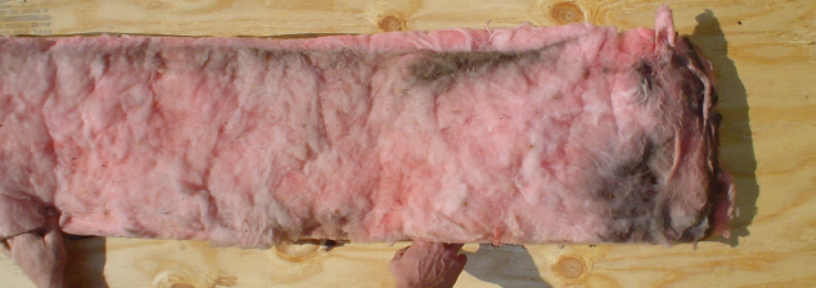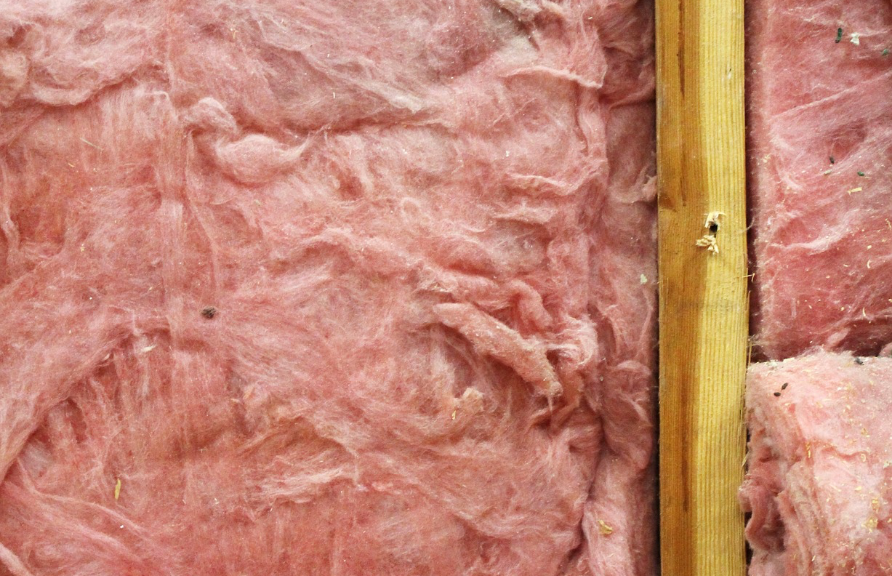Fiberglass
- Manufacture’s Stated R-3.2 per inch
- Excellent Soundproofing Material
Con
- (BPI) Installed Fiberglass Actual R-value Range changes. (R-2.5 -R-0.7 per inch)
- Fiberglass needs to be completely encapsulated in order to function properly
- Unstable R-Value
- Low effectiveness for handling Conduction
- Only slows down Convection Loops
- Does not prevent Air Infiltration
- Air-Intrusion- dramatically effects R-value
- Not a Vapor Retardant
- Will not stop moisture Drive- moisture moves through it
- Absorbs Water / Saturating Fiberglass
- Does not Air Seal
- Does Not Prevent Radiant Heat Gain
- Can compress then loose R-value

Dirty Fiberglass Insulation Indicates Air Leakage. The air within all homes contains dust and other microscopic debris, when the air escapes through the fiberglass it acts like an air filter removing all the particles leaving the fiberglass filthy as seen above.
Fiberglass insulation can be an effective insulation only when installed properly with an additional air sealing and vapor barrier totally encapsulated on both sides and zero air infiltration. One of the major issues with fiberglass insulation is, it does not air seal. In addition, when there is air leakage or moisture accumulation it renders the fiberglass ineffective and lowers the R-value to nearly nothing. If your home has drafts, you are losing conditioned air that your hard- earned money paid for
Cellulose
- Typical R-value is between R- 3.6 & https://mightyjungle.com.au/cialis-tadalafil-online/ R-3.8 per inch
- Excellent Soundproofing Material
- Mild to Medium effectiveness against Conduction
Cons
- Unstable R-Value
- Only slows down Convection Loops
- Does Not Prevent Air Infiltration
- Air Intrusion- dramatically effects R-value
- Not a Vapor Retardant
- Will Not Stop Moisture Drive- Moisture moves through it
- Absorbs Water / Saturating Cellulose
- Does not Air Seal
- Does Not Prevent Radiant Heat Gain
Much like fiberglass, under the right circumstances cellulose can be an efficient insulation. Within a sealed wall cavity it can work substantially well for a while until settling occurs. When in a wall cavity, gravity can cause the cellulose to compact downwards on itself and can leave a gap in the top of the cavity. Although the compacted cellulose works well as an insulator, a gap at the top would allow heat loss.
Energy “Shoot-out” at the UC Corral
University of Colorado at Denver School of Architecture Energy conservation efficiency of two buildings that differed only in the insulation. Building A: insulated with 5.5 inches of cellulose in the walls and R-30 of loose-fill cellulose in the ceiling. Building B: insulated with R-19 unfaced fiberglass batts in the walls and R-30 Kraft faced batts in the ceiling
Comparison
CELLULOSE INSULATED BUILDING WAS 36% – 38% TIGHTER, USING 26.4% LESS ENERGY THAN THE FIBERGLASS!
